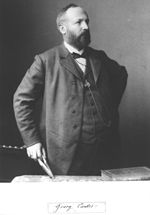Georg Cantor: The mathematician of the century and the discovery of the infinite
Georg Cantor: The Mathematician of the Century and the Discovery of the Infinite is a narrative non-fiction book by the American author David Foster Wallace about the mathematical developments that led the German mathematician Georg Cantor to set theory .
content
The book describes the problems in dealing with the infinite that have existed since classical antiquity , as they were shown, among other things, in the paradox of Zenon by Elea , it was not understood how an infinite number of time intervals can combine to form a finite one. The discovery of irrationality by the Pythagoreans is also related to an infinite process to achieve these irrational numbers, the actual infinite was rejected. These conceptual difficulties continued into the 17th century without any clarification. The developing analysis made use of the infinitely small, concepts such as function and continuity remained nebulous. Important problems with the infinite, such as the convergence of series , especially those of the Fourier series , were approached rather speculatively, since the "geometrical rigor" demanded by the opponents of analysis could not be achieved with the means at the time. Thus, by giving an integral formula for the Fourier coefficients , Fourier claimed that every function could be developed into a Fourier series. What is it that distinguishes the real numbers as in some sense complete, continuous or uninterrupted totality from the rational numbers? What do we have to imagine by continuous transitions? Only the clarifications by Karl Weierstrass ( - -Definition ) and Bernhard Riemann (which functions have integrals ?) Created a remedy here and made the question of the existence of the actual infinite emerge more clearly. Richard Dedekind succeeded in defining the real numbers precisely by means of what are known as Dedekind cuts , but used the existence of infinite sets, which was hardly accepted at the time.
It is against this background that Georg Cantor appears; he not only uses infinite quantities, but also shows different degrees of infinity. He succeeds in defining real numbers by means of fundamental sequences of rational numbers and he can grasp the phenomenon of completeness by showing that every fundamental sequence of real numbers converges to a real number. In the then classical problem of Fourier series, he investigates which functions unique Fourier series have. In doing so, he succeeds in being able to allow discontinuities, initially finitely many, then infinitely many, whereby he is naturally led to derivatives of sets and their iterations. This is considered to be the beginning of Cantor's set theory.
Cantor resolves the so-called Galilean paradox, according to which there are just as many natural numbers as square numbers , with the concept of uniformity . He proves the countability of the rational numbers as well as the statement known today as Cantor's theorem that the power set of a set is always of greater power than the set itself. He uses a diagonal argument to prove the “continuum”, that is, the set of real numbers, as not countable, which leads to the question of whether there are further thicknesses between the countability and the thickness of the continuum, the non-existence of which is known as Cantor's continuum hypothesis . The book closes with Cantor's unsuccessful attempts to solve the problem of the continuum hypothesis and hints of the work of Kurt Gödel and Paul Cohen on the independence of the continuum hypothesis from the Zermelo-Fraenkel set theory , which explains Cantor's failure.
Delimitations
Most of the above terms are presented to the reader in narrative form, whereby in some places the mathematical precision naturally has to give way to the conveyance of an impression. There are numerous footnotes on the terms and on the mathematicians featured. Some biographical information on the person of Cantor can be found in the fifth chapter, but the book cannot be described as a biography , the elaboration of the mathematical development of set theory is clearly in the foreground.
literature
- David Foster Wallace: Everything and More - A Compact History of . WW Norton & Company, 2003
- German first edition: David Foster Wallace: Georg Cantor: The mathematician of the century and the discovery of the infinite . Translated from American English by Helmut Reuter and Thorsten Schmidt. Piper, Verlag 2007, ISBN 3-492-04826-9
- German paperback edition: David Foster Wallace: The discovery of the infinite: Georg Cantor and the world of mathematics . Piper, Munich 2009, ISBN 3-492-25493-4




